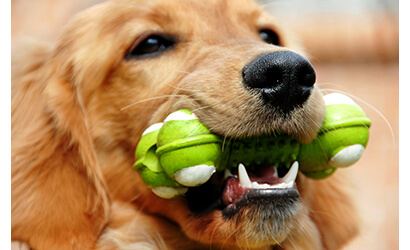
Pet owners spoil their pets. There’s no way to get around that. We bring them their favorite things as often as we can and offer them only the finest, most luxurious beds to sleep in. Sometimes, pets even sleep in our beds! We even offer them an abundance of different toys to keep them busy during the day because we love them and we want them to be happy and mentally stimulated.
Even though people who do not own pets seem to think that dog toys are some sort of luxury item, this is not true. Toys are things that dogs need, and they need more than one kind of dog toy. Toys for dogs are similar to stress balls for people in the way that they can calm a dog down after a tough day. Soft toys that dogs can "mother" can help with their nurturing instincts, while squeak toys engage their attack instincts. Balls, tug toys and Frisbees let dogs to interact with their owners in a fun, active way.
Dogs owning toys is not something that can be negotiated, and pet owners always ensure that their pooches have all of the toys that they could need; however, just as many pet owners have fear concerning the kind of toys that they’re giving their dogs. There’ve been far too many horror stories out there of pets playing with toys and everything going awry for owners not to be wary.
When it comes down to it, picking out a toy can be difficult. There are many ads for pet toys, and while the flashier ones may seem appealing, they are not always ideal. Everything that glitters is not gold, as they say, and that’s definitely true for pet toys! Usually, those that are more brightly colored, for example, often come with a cost. The danger in brightly colored toys lies in the dyes and the paints. These paints often contain chemicals and lead, especially if they come from other countries such as China. Because of this, some toys can be dangerous. This includes toys that may have other properties besides paint and dyes.
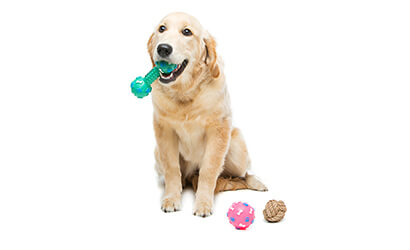
By not choosing toys wisely, dogs may pay the cost. Some of the more familiar issues with pet toys include stomach obstruction and choking, where pieces of the toy accidentally get swallowed. Since pups and dogs use their mouths to play, it is possible that they could ingest toxic materials as well. Still, the FDA does not regulate dog toys, and the Consumer Product Safety Commission only chooses to regulate toys with the safety of humans, not the dogs, in mind. For this reason, it can be difficult to determine which toys are safe and which ones are not safe for your pet to consume.
This is a sad reality that pet owners need to consider when they buy toys for their pets: they can certainly become injured. For instance, there was a famous story about a dog’s tongue getting caught in the hole of a ball. After a tedious and painful medical procedure, the dog’s tongue eventually had to be amputated. Surprisingly, this isn’t the first incident of that kind, and other dogs had been harmed and sometimes killed by toys. It took a few of these incidents before the company recalled their toys, so pet owners must do their part to keep a look out for toys like this.
Such concerns don’t stop when it comes to choking hazards and injuries. Preservatives, dyes, and chemical residues are not anything new, but are still a risk that can affect your pup, especially with the new wave of toxic imported toys from China. There are a number of toys that have been reported by ConsumerAffairs.com that contained toxic heavy metals such as chromium, lead, and cadmium. These can be classified as neurological poisons to carcinogens, and they are released when a dog chews or licks on the toys. Even with the influx of toxic toys internationally, this does not mean that all products made in the United States are inherently safe.
The American Pet Products Manufacturers Association responded to the investigation done by Consumer Affairs and said that products were always checked by suppliers to ensure that their products were not made with lead or another sort of poison. A few pet companies, which include PetSmart, also indicated that they do random tests on their products to test for lead. To read more about American Pet Products Association on products & the law, see here.
Still, this investigation shows that there are no national standards for regulating toxins like lead and cadmium in pet toys. Many companies use a benchmark that states 600 parts out of every million can have lead, which is sadly the regulated amount according to federal law for even children’s toys to have.
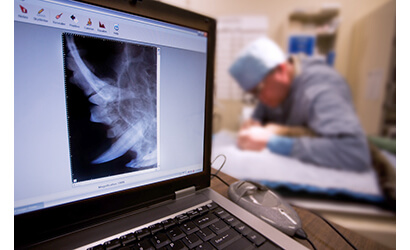
Veterinarians are wondering if the level that humans can stand should also be the same level that pets are expected to stand. They have asked for acceptable standards and levels of toxins such as lead to be specifically set for pet toys. Could there be a risk to pets when they chew on toys with lead like there are for children? Of course. Much more lead will be leached off of something when it is wet. Even still, it’s unknown how much lead a dog can take compared to a child.
The problem also lies in sourcing overseas. When this happens, manufacturers are not connected to who is making the materials, what raw materials are being used, or what sort of working conditions are put into place. When a company sources domestically it is easier to know what’s happening in those manufacturing plants along with having regulations that stand against toxins. It’s advisable that if you want a better chance of having a safer pet, you shop for toys that were made in the United States.
Another thing that you need to think about is not where the toy is made, but how your dog chews on it as well. Most dogs tear toys instead of gently chewing on them and use their molars and premolars. These teeth sit further back in their mouths, and any toy that ends up being chewed on that far back in their mouths can be a risk. For this reason, it’s important that you are buying toys that your dog won’t even be able to fit that far back in his or her mouth.
No matter what stage of their lives they are in, knowing how your dog chews also means choosing toys that are set around that life stage. A dog who is just breaking in his teeth won’t want to play the same way a senior dog whose teeth are worn down will, for instance.
After figuring out what sort of toys your dog might like, use your senses to pick them out. If you smell a strong chemical smell, this could indicate the presence of actual chemicals. Fabrics that are brightly dyed may have certain toxins in them that can leach out when they are wet. You should avoid toys that are stain resistant or fire retardant since they could contain chemicals such as formaldehyde. Look at the labels and go to the websites of toy manufacturers to learn more about the toy before you buy it. Most importantly, always watch your dog when he or she plays and look for signs of alarm.
Pet Toys from Around the House
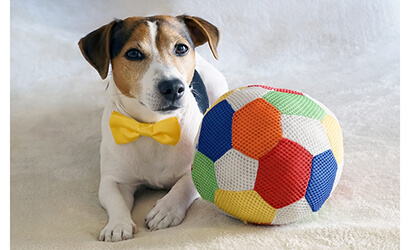
Some pet parents may think that the best idea would be to give their pets a toy that comes from their own home. While cats can be picky about which toys they want to play with, a dog is often going to be willing to play with just about anything. While this is great and can save you money, it also means that you must be extra careful watching your dogs play with household items.
There are a number of variables that contribute to the danger or the safety of a pet toy, and a lot of them depend on the size of your dog and activity level. While the safety of any toy is not guaranteed, the following guidelines could be followed if you want to give your dog a household toy:
The toys that are the most attractive to your pooch are going to be things that are, of course, the most dangerous. Safeguard your home by taking away rubber bands, ribbons, strings, panythose, children’s toys or any other item that could be easily swallowed. You will also want to ensure that the toys you get are the right size for your pup; if you get a toy that is too small, it could easily be swallowed or get stuck in your dog’s throat.
With squeaker toys, always supervise their play. Since squeak toys engage their attack senses, they may shred the toy when they play with it which could mean they ingest a part of it. This could cause serious issues. You also want to dog proof any other toy that is not already safe for dogs, including strings, ribbons, eyes or any other part that a dog could chew off and swallow. When a toy breaks into pieces or tears, throw it away. Look at labels on stuffed toys and make sure they are safe for children under three and that they do not have any dangerous fillings. Fillings like this include polystyrene beads.
Types of Recommended Toys
Active Toys
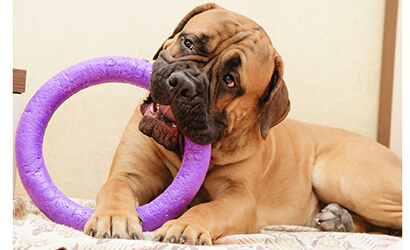
These include rubber, hard toys that are available in plenty of sizes and shapes and can be great for dogs of all sizes. Dogs that enjoy tug of war can benefit from a rope toy like the woven types with "bone" shaped ends. Tennis balls make great fetch toys but are not great chew toys; if they become chewed, throw them away so that they do not become a choking hazard.
Comfort Toys
Some dogs enjoy simply carrying around a small, soft toy, and some like to shake them around to engage different hunting instincts. Choose one that can withstand the intensity of these instincts. Dirty laundry that smells like the pet owner are also great choices, but be sure that they do not shred the clothing.
Distraction Toys
Toys filled with broken up treats can help a dog stay busy for hours. You can even put peanut butter in the toys if your vet approves it.
Let’s take a closer look at what kind of dog and car toys are considered toxic aside from ones made in China.
Leather Chews and Toys
This includes balls like baseballs and soccer balls that are made with leather. Since leather has to go through what is known as tanning to remove the animal hide, it is often exposed to arsenic. Arsenic is the most commonly used tanning agent, followed closely by lime, zinc, lead, chromium, bleach, sulfites, and a number of acids.
Rawhide Bones
Rawhide bones also go through the process of tanning, so they will contain arsenic, lime, zinc, lead, chromium, bleach, sulfites, and other chemicals as well. These rawhides are also treated using formaldehyde, which is a known carcinogen. In order to make these treats desirable to pets after they have been tanned, they will also add in a flavor to the bone. These bones are not only a chemical hazard, but they have been known to cause obstructions in your dogs digestive tract, which is more often fatal than it isn’t.
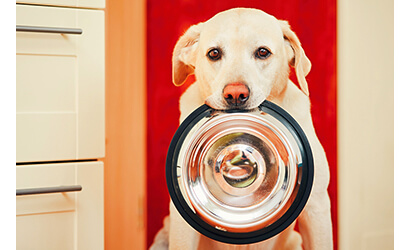
Ceramic Bowls and Painted Toys
Toys that are painted in any way are considered to be toxic, especially the colorful ones from China. The color often comes from highly toxic lead paint that dogs chew off and ingest. The paint won’t stay on the plastic after a while, so this is a risk that you simply should not take. Another product that is toxic in the same way is painted ceramic bowls. These are often used as water bowls and dishes for your pet, and each time they drink from them, they can ingest lead from the paint that is used to craft them.
Dyed Toys
Anything that has been dyed can release toxins when it is in your pet’s mouth, as wet toys are known to leach toxins more than dry ones, and let’s face it: the toy is going to go into the dog’s mouth.
Anything dyed will release chemicals into your dog or cat’s mouth and body. Fluffy cat toys and tennis balls are the ones that come to mind the most, although there are numerous rope toys on the market for dogs that are either bleached rope, or rope made with colorful strings. Both are toxic.
Vinyl Toys
Vinyl often contains an assortment of additives that are known to be toxic including lead; however, the ones that are being talked about the most are phthalates. Phthalate is the name for human-made chemicals that, when worked into vinyl, makes the vinyl soft and easy to chew. Phthalate can move in and out of the vinyl material with ease, meaning it can get into your dog’s mouth just as easily.
FAQ on Pet Toys
Q: Is it safe to stuff cotton into a pouch, sew it closed and give it as a toy to a puppy or a dog?
A: No matter what the chew toy is, it is important that the dog is supervised. Dogs can chew through just about anything and they can also swallow almost anything. A dog that is left alone in the yard, at home, or in another room should not have a toy that they play with alone, including a toy that is stuffed with cotton or another material.
Q: Is blue jean material okay for a dog to play with? I am worried because of the color and dye used in the manufacturing process, but I want to be able to recycle my old jeans that I do not wear anymore.
A: There have been no notable reports of blue jeans that are used in dog toys eliciting harm to other dogs, and people have even used jeans as a tug of war toy that has not seemed to pose a problem. Still, there may be dogs that are sensitive to the material that is used in the dye. Another danger is the fact that if a dog chewed up the jeans into pieces and ingested them, they could choke or cause some sort of a blockage or obstruction that could be lethal.
Q: I like to make toys but am not sure where to find them or what kind of material I should be getting.
A: It is suggested that to prevent any sort of chewing or shredding of the squeakers, the toy should be encased in plenty of material like an athletic bag, nylon rain jacket or a backpack. You can find used items at a consignment shop. Go for more than one layer if they are heavy chewers.
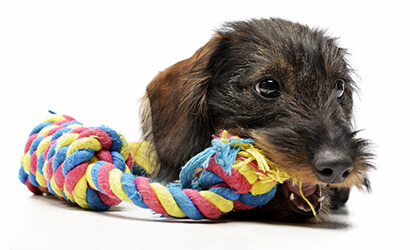
Q: Can I use or buy cotton squeak toys?
A: It is important to always assume that a puppy will be able to tear apart any chew toy until you are there to see differently. Never leave a puppy alone with a chew toy with cotton in it. It is recommended that you avoid cotton altogether. Cotton toys typically are not as durable as some other toys available, and this means that they can be shredded and eaten with greater ease. Instead, you may note that your puppy is unable to chew through heavier toys. These include big rubber toys. If you insist, a homemade chew toy is going to need supervision. Once more, until you know what your puppy or dog can chew through, don’t leave them alone with anything they can choke on, chew, or potentially swallow, including furniture, clothes, shoes, cleaning supplies, and so on.
Q: When I want to pick out a new bone for my dog, how do I know which bone is the right one for them?
A: No matter the kind of bone you want to get, you need to consider the type of chewer that your dog is. Then, consider whether you want to get them a nylon bone, a rawhide bone, or a real bone. You may also want to think about the size that your dog is and pick a bone that is going to fit his mouth and his teeth the best. This includes getting a bone that is of the right size where it will not slip into the back of his or her mouth.
Q: How can chewing on a bone improve the dental health of my dog?
A: When your dog spends time chewing on a bone, the chewing action has a number of benefits. This includes controlling the buildup of tartar, scraping away plaque, and helping to stimulate their gums. All of these things can help to minimize the smell of bad breath. It can also help to keep their teeth whiter and help reduce the issues that arise when your dog develops potentially serious dental conditions.
Q: What makes bones that are marketed as "dental bones" different?
A: As stated before, all bones are going to be beneficial to a dog’s oral and dental health in some way or another. Dental bones are designed specifically to clean a dog’s mouth and promote healthy gums and teeth, even in the case of a dog who chews aggressively. These dental bones often come with a flavor that helps eliminate bad breath as well.
Q: How can a bone help prevent negative chewing activities?
A: When you give your dog a bone, it can help to satiate the innate chewing instinct that your dog possesses. This can also assist you in relieving the pain that comes with teething. It’s better to give your puppy a positive thing to chew on when they teethe instead of your furniture. If you let your dog chew on the properly sized bones from puppyhood to adulthood, you increase the chances that he is going to want to chew on a bone over your possessions as he or she ages. Give your dog a wide selection of bones to help keep them interested.
Q: My dog can chew through a bone in no time at all. Which bone should I choose so that he can enjoy a bone for longer?
A: There are a number of different bone types out there. You can choose nylon bones that are essentially going to be indestructible and will wear down in a slow manner. These bones also will not splinter and cause concern. Pressed rawhide bones that have several layers welded together are great for those aggressive chewers as well.
Q: A nylon bone sounds great, but I am worried: is nylon a safe material for dogs to chew on?
A: Nylon has never been reported to give a dog a health issue when chewed on. This is especially true when it comes to nylon bones. Nylon is a harmless plastic that is used in a number of different things, but it is used in dog bones to help reinforce it and give it strength. If your dog happens to ingest a small piece of nylon, this material is one that will very easily pass through their digestive system and get eliminated.
Q; Are there any bones that come with natural ingredients?
A: Yes. There is a selection of bones available for purchase that offer natural ingredients. These are great not only for eco-conscious pet parents put for pet parents who are more wary than others about giving their dogs regular bones. These often come in flavorful varieties that can satisfy your dog’s chewing needs for hours on end.
Q: Is there such a thing as a low-calorie bone for a dog?
A: There are indeed low-calorie dog bones. These are an excellent choice for dogs that need to lose weight for health-related reasons. Bones like these are often American, made for peace of mind, and have no sugar, salt, sweeteners or any artificial flavors. Low-calorie treats will often be low fat as well.
Q: Are real bones safe for my dog to chew on?
A: There’ve been very few instances of health problems in dogs that stem from the action of chewing on bones. That said, every real bone that your dog gets his paws on is going to pose at least a minimal risk of splintering. When a bone splinters, it can cause blockages in the throat, stomach, or intestines, which can cause a potentially serious or lethal problem. For this reason, it’s important to supervise the bones that your dog chews on, no matter if they are real bones or an artificial bone such as nylon. This is so that in the event that splintering does happen, you’ll be able to respond quickly or prevent it from happening at all. Real bones are often designed to wear down over time, so this is not much of a concern. Still, it isn’t recommended that you give dogs bones from your leftover human food since you cannot be sure of how hard the bone is, especially after it has been softened by being cooked.
Q: How are rawhide bones made?
A: Rawhide bones are often put through great lengths to ensure that their quality is perfect and suitable for dogs to chew on. They are usually made from high quality premium beef hide and produced under the strictest of quality guidelines and standards. Rawhides are also often knotted and wrapped around over and over to give you the most bone for your money.
Q: Is it important that I supervise my dog while he is chewing on a rawhide bone?
A: It is definitely recommended that you supervise your dog while chewing on any bone, rawhide or not. If you notice that while he is chewing that he breaks off a smaller piece, take it away from him. This will help reduce the risks of intestinal or stomach blockage and reduce the risk of choking.
A: Are bones a good choice for me to give to my senior dog?
A: Yes. If your older dog has a healthy set of teeth, bones are great for them, just as they are for dogs throughout any stage of their lives. Bones provide not only abundant entertainment but they can stimulate the brain of senior dogs, which is highly beneficial. Bones are especially wonderful for those senior dogs that are not very active anymore.
Q: I would like to give my dog a bone. The problem is, I do not want to give my dog a bone that is going to stain my rug or light colored carpet. Does one exist?
A: Yes. There are different bones that have been designed to leave behind no trace of its existence on any floor.
Q: My dog does not like certain types of bones, I have noticed. What do I need to do?
A: Your dog, just like people, might be picky when it comes to what he likes to do for fun or to eat. If your dog does not like the bone that you have given to him, try out a different kind of bone instead. Keep trying until you find a bone that your dog enjoys chewing on. Your dog will thank you for your continuous efforts when he or she gets to enjoy a healthier mouth, entertainment, and the other benefits that chewing a bone can bring to your dog.
Affiliate Message
Because we love and value our pets just as much as you do, we’ve chosen to partner up with another site that cares for their pets in the same way. StuffPetsLove is affiliated with Pooch Perks, a monthly subscription website. Their website sends out a box of all natural goodies for your pet once every month to allow you to pamper them. By being an affiliate with them, we get the funding to write more informative articles for you to read along with in-depth reviews on other products. We do it all for the love of pets and their parents!
